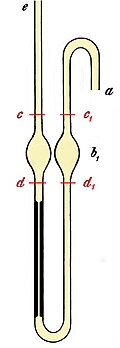Ostwald viscometer
The Ostwald viscometer is a device for determining the dynamic viscosity of liquids in physical chemistry . It was developed by Wilhelm Ostwald (1853–1932) and historically it was also called Ostwald's tenacity meter .
The Ostwald viscometer is one of the capillary viscometers in which the kinematic viscosity of the liquid is determined by measuring the time it takes a measuring volume to flow through a capillary . According to the Hagen-Poiseuille law , the kinematic viscosity is then proportional to the flow time t:
K is the capillary constant, which only depends on the type of viscometer. K is always specified for commercially available capillary viscometers, e.g. B.
- Flow time 45 s, K = 0.022
- Flow time 85 s, K = 0.011
- Flow time 125 s, K = 0.008,
but can also be determined by comparison with a known liquid (e.g. water at 20 ° C has = 1.0 cSt = 1.0 mm² / s).
The determination of the viscosities of macromolecular solutions (variables without asterisk) can also be carried out by comparison with the viscosity of the pure solvent (variables with an asterisk). Then with the dynamic viscosity :
With
- = dynamic viscosity
- t = flow time
- = Density
Since the densities of solution and solvent are usually very similar:
applies approximately:
use
The calibrated Ostwald viscometers (ISO 3105) are widely used today for routine measurements in the form of the " Ubbelohde capillary" improved in 1907 because of their simplicity and robustness .
Web
- Wilhelm Ostwald, Grundriss der Allgemeine Chemie , 2nd ed. 1891, p. 1xx. - 3rd ed. 1899, pp. 153–156 .
- W. Pleißner, Investigation of the relative internal friction in edible fats and fatty oils , Archiv d. Pharmacy 1904 , 24ff .
- Friedrich Kohlrausch, Textbook of Practical Physics , 1st ed. 1901, p. 221ff . - 3rd edition 1910, pp. 258ff . - 24th edition 1996, p. 193 (pdf-p. 51).










